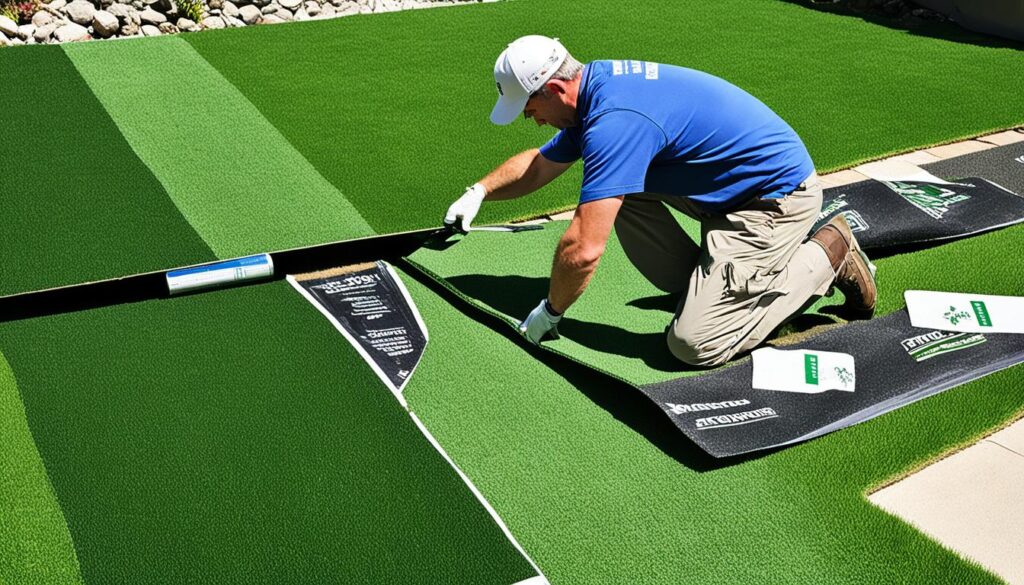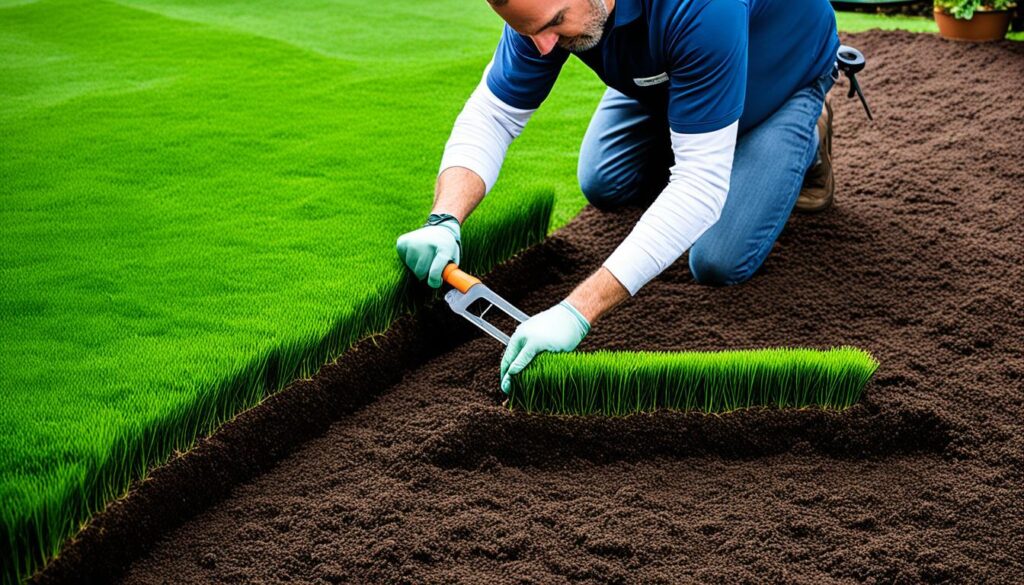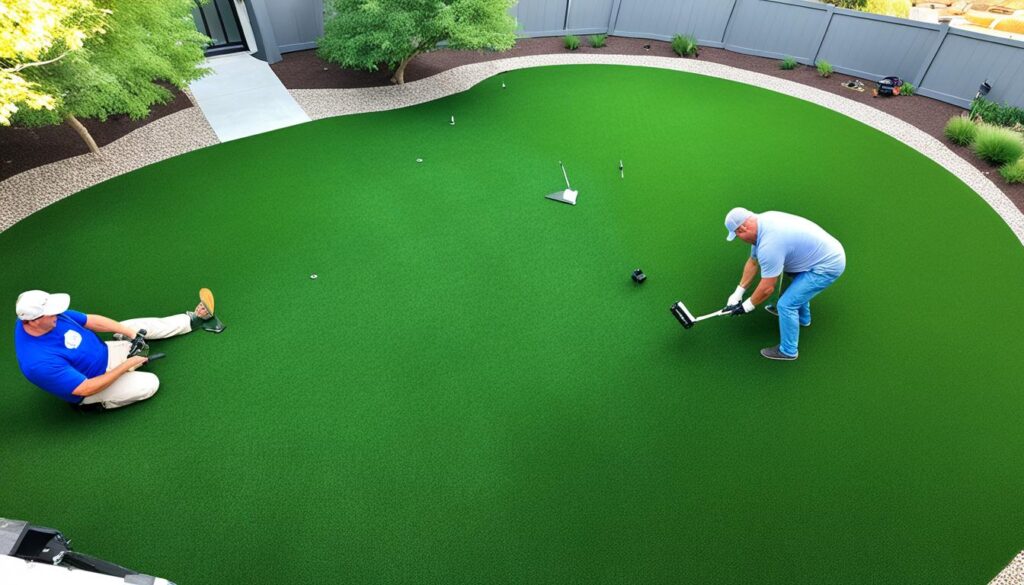
When it comes to installing artificial grass, there are several key factors that you need to consider to ensure a successful outcome. Whether you’re looking to enhance the appearance of your lawn or create a low-maintenance outdoor space, taking these factors into account will help you achieve the desired results. If you’re planning to install artificial grass in Prescott, AZ, it’s essential to consider the unique climate and conditions of the area. Let’s explore the key factors to consider for installing artificial grass, both in general and specifically for Prescott, AZ.
Key Takeaways:
- Choosing the right type of artificial grass is crucial for a successful installation.
- Proper ground preparation, including removing existing vegetation and leveling the surface, is essential.
- Following the correct installation steps, such as laying the base material and securing the grass, is crucial for a seamless installation.
- Maintaining and caring for artificial grass is necessary to preserve its look and durability.
- For artificial grass installation in Prescott, AZ, it’s important to consider the local climate and conditions.

Now, let’s dive deeper into each of these key factors to ensure a successful installation of artificial grass. Whether you’re a homeowner or a landscaping professional, these insights will help you make informed decisions and achieve beautiful, long-lasting results.
Choosing the right type of artificial grass
When it comes to artificial grass installation, selecting the appropriate type of artificial grass is a critical step in achieving the desired outcome. Consideration needs to be given to several factors, including pile height, blade shape, color, and material composition. With our expert tips and best practices, you can make an informed decision and ensure a successful installation that meets your specific needs.
Factors to Consider
- Pile height: The height of the grass blades can affect the overall appearance and feel of your artificial lawn. Shorter piles provide a neat, manicured look, while longer piles offer a more lush and natural appearance.
- Blade shape: The shape of the blades affects the overall durability and performance of artificial grass. Options range from flat, straight blades to curved ones, each offering unique characteristics in terms of resilience and resilience.
- Color: Artificial grass comes in a variety of shades, including different tones of green and even brown for a more realistic look. Consider the surrounding environment, style preferences, and desired aesthetic when selecting the color of your artificial grass.
- Material Composition: The material composition of the artificial grass determines factors such as resilience, drainage, and heat absorption. Common materials used include polyethylene (PE) and polypropylene (PP), each with its own distinct properties and benefits.
By considering these factors, you can choose the right type of artificial grass that aligns with your specific requirements and creates the desired visual impact for your outdoor space.
| Factor | Pile Height | Blade Shape | Color | Material Composition |
|---|---|---|---|---|
| Options | Short or long | Straight or curved | Various shades | PE or PP |
| Characteristics | Neat or lush appearance | Resilience and performance | Realistic look | Drainage and heat absorption |
This table provides a quick overview of the factors to consider when selecting the right type of artificial grass for your installation. By understanding these factors, you can make an informed choice that will lead to a successful and visually appealing result.
Preparing the ground for installation
Proper ground preparation is essential for a successful artificial grass installation. By following a comprehensive checklist and addressing key essentials, you can ensure a solid foundation for your artificial grass and achieve a professional-looking result.
1. Remove Existing Vegetation
Prior to installing your artificial grass, it is crucial to remove any existing vegetation, including grass, weeds, and debris. Use a shovel, rake, or a powered lawn sweeper to clear the area thoroughly. This step will prevent unwanted growth and ensure a level surface for the installation.
2. Level the Surface
For a smooth and even artificial grass installation, it’s essential to level the surface. Use a rake or a lawn roller to remove any bumps, hollows, or uneven areas. This will help create a consistent base for your artificial grass, minimizing the risk of tripping hazards and providing a visually appealing finish.
3. Address Drainage Issues
Proper drainage is critical to prevent water accumulation and maintain the integrity of your artificial grass. Check the area for any drainage issues, such as pooling water or inadequate slopes. If necessary, consider installing a drainage system or making modifications to ensure that water flows away from the installation area.
4. Use Weed Barrier Fabric
To further prevent weed growth, it’s recommended to use a weed barrier fabric. This fabric acts as a protective layer, inhibiting the growth of weeds while still allowing proper water drainage. Install the weed barrier fabric over the prepared surface, ensuring complete and secure coverage.
5. Compact the Soil
Before proceeding with the artificial grass installation, use a soil compactor or a tamper to compact the soil thoroughly. This will stabilize the ground and provide a solid base for your artificial grass. Compact the soil in layers, working your way from the outer edges towards the center.
6. Apply a Base Material
Depending on the specific requirements of your artificial grass installation, it may be necessary to apply a base material. This can include crushed rock, gravel, or decomposed granite. Spread the base material evenly over the compacted soil, ensuring a depth that allows for proper drainage and a stable surface for the artificial grass.

| Artificial Grass Installation Checklist |
|---|
| 1. Remove existing vegetation |
| 2. Level the surface |
| 3. Address drainage issues |
| 4. Use weed barrier fabric |
| 5. Compact the soil |
| 6. Apply a base material |
Installing the artificial grass
Now that the ground has been properly prepared, it’s time to move on to the installation of the artificial grass. This section will provide a comprehensive guide outlining the step-by-step process to ensure a successful and professional installation.
Step 1: Laying the Base Material
The first step in installing artificial grass is to lay the base material. This typically involves spreading a layer of crushed rock or decomposed granite evenly across the prepared surface. The base material provides stability, improves drainage, and helps prevent the growth of weeds or other vegetation.
Step 2: Securing the Grass
After the base material has been spread, it’s time to roll out the artificial grass. Carefully position the grass over the prepared area, ensuring it fits perfectly without any gaps or overlaps. Once in place, secure the edges of the grass using landscape spikes or adhesive. Take care not to stretch the grass excessively as this can lead to unnatural-looking creases or wrinkles.
Step 3: Joining Seams
If your artificial grass installation requires the use of multiple rolls, it’s important to properly join the seams for a seamless appearance. To do this, carefully trim any excess grass from the edges using a sharp utility knife. Align the edges of the rolls, ensuring they fit together snugly. Apply adhesive or seaming tape along the seam and press the grass firmly together. Use weights to hold the seam in place until the adhesive has fully cured.
Throughout the installation process, it’s essential to pay attention to detail, ensuring the artificial grass is properly aligned, tightly secured, and free from imperfections. Taking the time to follow these steps for successful artificial grass installation will result in a beautiful, long-lasting outdoor space.

Maintaining and caring for artificial grass
Proper maintenance is crucial for preserving the look and durability of your artificial grass installation. By following expert advice on artificial grass installation, you can ensure that your investment lasts for years to come. Here are some artificial grass installation tips for maintaining and caring for your synthetic turf:
Cleaning
Regular cleaning is essential to keep your artificial grass looking fresh and pristine. Use a leaf blower or a stiff brush to remove leaves, debris, and pet hair from the surface. For more thorough cleaning, rinse the grass with a hose and use a mild detergent if needed. Avoid using harsh chemicals or power washers as they can damage the fibers.
Managing Foot Traffic
Artificial grass is designed to withstand heavy foot traffic, but it’s important to manage it properly to prevent wear and tear. Consider creating designated walkways or pathways to divert traffic from high-use areas. If you notice any flat or matted spots, simply brush them with a stiff broom to restore the grass’s natural appearance.
Dealing with Stains and Spills
Accidents happen, and artificial grass is no exception. Promptly address stains and spills to prevent permanent damage. Blot the affected area with a clean cloth or paper towel to absorb the spill. For tougher stains, use a mixture of mild soap and warm water to gently scrub the area. Rinse thoroughly and allow it to air dry.
Preventing Weeds
One of the advantages of artificial grass is that it significantly reduces the growth of weeds. However, occasional weed growth may still occur along the edges or through small gaps in the installation. To prevent weeds, regularly inspect the perimeter and remove any unwanted vegetation. Consider using weed barriers during the initial installation process. This article is a must-read – don’t skip it.
Seasonal Maintenance
As the seasons change, so do the maintenance needs of your artificial grass. During the warmer months, ensure that your grass receives proper hydration by lightly spraying the surface. In colder climates, remove any snow or ice buildup using a plastic shovel or soft bristle broom. Additionally, check the infill levels periodically and add more if necessary.
Following these expert tips on artificial grass installation will help you maintain a beautiful and long-lasting synthetic lawn. By dedicating a little time to regular care and maintenance, you can enjoy the benefits of artificial grass throughout the year.
| Maintenance Tasks | Frequency |
|---|---|
| Cleaning | Weekly or as needed |
| Managing Foot Traffic | Ongoing |
| Dealing with Stains and Spills | As soon as they occur |
| Preventing Weeds | Regularly inspect and address |
| Seasonal Maintenance | Spring, summer, fall, and winter |
Artificial grass installation in Prescott, AZ
When it comes to installing artificial grass in Prescott, AZ, there are some important factors to consider that are specific to the local climate and conditions. Prescott’s climate is characterized by hot summers and mild winters, which can have an impact on the performance and longevity of your artificial grass.
One key tip for artificial grass installation in Prescott, AZ is to choose a grass variety that is heat-resistant and can withstand high temperatures. This will ensure that your grass remains green and vibrant even during the hottest months of the year. Additionally, opting for artificial grass with excellent drainage capabilities will help prevent water accumulation and potential damage.
Water usage is another important consideration in Prescott, AZ, where water conservation is crucial. Choosing an artificial grass that requires minimal water or is entirely water-free can help you save on water bills while still enjoying a lush and green lawn. It’s also important to follow any local regulations or guidelines regarding water usage for artificial grass installation.
When installing artificial grass in Prescott, AZ, it’s essential to work with experienced professionals who are familiar with the local climate and can provide expert advice. They will help you navigate the unique considerations of the area and ensure a successful installation that meets your specific needs.
Yavapai Landscaping Prescott offers free quotes for Prescott and its surrounding areas for landscaping and tree services. This includes tree removal, trimming, stump grinding, land clearing, storm clean up, irrigation, and emergency tree service.











